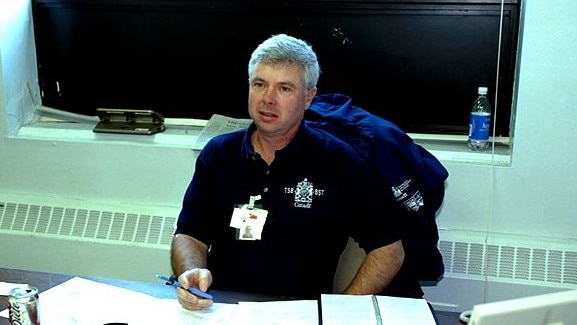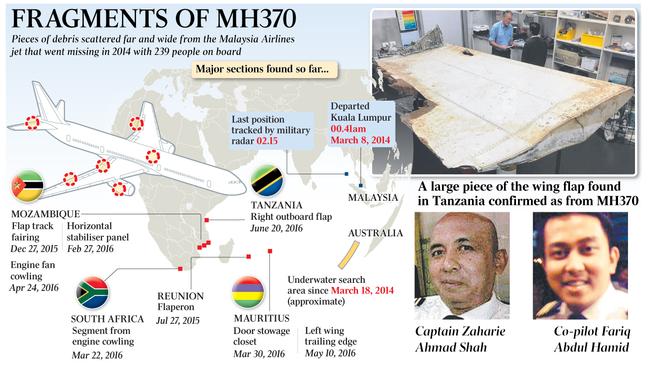Malaysia Airlines pilot ‘planned MH370 crash’
A Malaysia Airlines pilot planned the crash in the southern Indian Ocean down to the last detail, a new book argues.

The disappearance of MH370 is widely viewed as one of the greatest mysteries in the history of aviation. What could cause a huge Boeing 777 passenger aeroplane with 239 people on board to simply vanish into the night?
MH370 disappeared on a scheduled flight from Kuala Lumpur to Beijing on March 8, 2014. Evidence shows it flew to the southern Indian Ocean and that it is now resting at the bottom of the sea.
When the investigation authorities led by the Australian Transport Safety Bureau suspended the official search for MH370 on January 17, 2017, after nearly three years of searching, many people were disappointed by the lack of definitive answers as to what caused the plane to disappear. The hope for answers was renewed when a privately funded search for wreckage was restarted in January this year. Once more, the renewed search has so far failed to find the wreckage.
The searches for the wreckage of MH370 were based on a belief by the ATSB and its panel of international experts that for more than six hours the aeroplane was tracking to the southern Indian Ocean as an unpiloted aeroplane. Their belief has been that during that time, MH370 was flying on autopilot, without pilot input, and that it eventually ran out of fuel. They believe that at the end of its flight, MH370 entered an out-of-control high-speed descent, followed by a high-speed crash into the ocean.
The evidence that I will present proves that the unpiloted-aeroplane theory is not correct. The aeroplane did not dive at high speed into the ocean. Basic investigation techniques substantiate a very different scenario: the disappearance of MH370 was a man-made event. The evidence shows that the aeroplane was under the complete control of a pilot throughout the flight, and at the end of its flight, MH370 was intentionally ditched (landed in a controlled way) on the ocean surface.
The disappearance of MH370 was a deliberate, pre-planned act, conducted by a pilot who followed the exact sequence of events that he intended to follow. The pilot’s intention was to fly the aeroplane to a predetermined remote location in the southern Indian Ocean and to ditch the aeroplane in such a way that it would remain intact, and to cause the aeroplane to sink to the depths of the ocean without leaving a trace.
The turning point for the ATSB’s investigation, away from the unpiloted-aeroplane theory and towards the deliberate-act theory, should have come on July 29, 2015, with the discovery of the flaperon from the right wing of MH370. The physical evidence available from examining the flaperon should have proved to the ATSB that the aircraft’s flaps were extended (down) when it entered the water, and that the aeroplane was at a speed consistent with a pilot-controlled ditching.
After the recovery of the flaperon, there should have remained little doubt that a pilot was controlling MH370 at the end of its flight.
The MH370 investigation went down the wrong path because of an over-reliance on hi-tech investigation efforts. The investigators failed to properly assess the available evidence that should have informed them they were not dealing with an unpiloted aeroplane. The most glaring failure was in the primary task of conducting proper wreckage analysis.
If MH370 had experienced a high-speed diving crash, it would have produced tens of thousands of pieces of floating debris. Only about 20 pieces of wreckage confirmed to be from MH370 have been recovered to date. Each recovered piece had drifted to the east coast of Africa, far away from where the aeroplane had entered the ocean. Most of these pieces had remained buoyant because of the honeycomb materials used in their construction. A high-speed diving crash would have created at least hundreds of additional wreckage pieces with honeycomb-type construction. Had they actually been created, many more than 20 pieces would have already been discovered.
A high-speed diving crash would have created many pieces of other types of floating debris, including seat cushions, luggage pieces, clothing, life jackets, personal effects, neck pillows, etc. The wreckage field from a high-speed diving crash would contain countless items that would remain buoyant for a long time. Had they actually been created, we would have seen this type of debris arriving on the coast of Africa in significant amounts. The reason that more floating debris has not appeared is that it was never created in the first place. There was no high-speed diving crash.
All the evidence points to a relatively low-speed, pilot-controlled ditching on the ocean surface. There is no evidence of a high-speed diving crash. In fact, there is overwhelming evidence to contradict that scenario.
In a relatively low-speed controlled ditching, the aeroplane will take a number of seconds to come to a stop. There will be damage, but the aeroplane structure can survive relatively intact. In a high-speed diving crash, the energy levels are extreme, and the aeroplane is completely destroyed in a fraction of a second.

Swissair 111 was a McDonnell Douglas MD-11 airliner that crashed at high speed into the Atlantic Ocean off the coast of Canada in 1998 due to an on-board fire progressively incapacitating the aeroplane’s systems. I was deputy investigator-in-charge of that investigation. When Swissair 111 hit the ocean at high speed off Nova Scotia, it exploded due to the hydrodynamic pressure of impacting with the water and came apart into some two million pieces, none anywhere near big enough or intact enough to be even identifiable as a flaperon or a flap. In the case of MH370, essentially, the entire right-wing flaperon was recovered on the French Indian Ocean island of Reunion.
The flaperons are on the trailing edge of the wings and can be moved up and down. They are part of the flight-control system, helping the ailerons and spoilers to control the rolling movements of the aeroplane. On takeoff and landing, the flaperons also function as part of the flap system. They deflect down when the pilot selects the flaps to “down”. In normal circumstances, the flaps are partially extended (down) for takeoff, and fully extended (down) for landing. They are fully retracted (up) during cruise flight.
The official ATSB investigation contends that when MH370 struck the water in a high-speed diving crash, this flaperon was in its fully up position — that is, it was tucked neatly into the trailing edge of the wing, with no downward deflection, which is the position a flaperon would be in for cruise flight.
Photographs of the flaperon show it presents itself as being not deformed, or flattened, or squashed, or even dented. There is damage where it was ripped from its attachments, as would be expected.
A high-speed diving crash causes massive destruction and fragmentation of the aircraft’s structure, as with Swissair 111. The fuselage shatters and explodes outward, from the front all the way to the tail, creating countless numbers of pieces. The same destructive sequence takes place with the wings, and flaps, and flaperons, which are all hollow cavities.
The explosive rupture forces from the water would invade through the open leading edge, and rupture these pieces from the inside out.
Does it make any sense to you that the recovered flaperon could survive basically unscathed from an impact like that?
There is only one obvious answer — no.
You do not have to be an experienced investigator to make that judgment.
To me, it is inconceivable that any investigator, or anyone who claims to have investigation expertise, would not automatically think their way through this and do the calculations. They should realise that the high-speed diving-crash theory supported by the official investigation simply does not make sense, based on this evidence alone.
I am aware that other theories have been put forth to explain why the flaperon from MH370 did not sustain impact damage. Some people contend that the flaperon had already fallen off the aeroplane before the aeroplane hit the water. That did not happen.
In the case of “flutter” of control surfaces during a high-speed diving crash, there will be signs of repetitive pounding on the attachments that hold the piece to the aeroplane. Each individual vibration will potentially leave a pounding mark at the attachment, and there can be a countless number of vibrations. In MH370, there is no such damage.
Now that we have made observations about the general condition of the recovered right wing flaperon, let us turn to examining its trailing edge.
The flaperon is made primarily of composite material. We see at the trailing edge that it has been shredded away progressively, from the back towards the front. The original trailing edge is completely gone. It looks like it has been eaten away, or eroded.
Most certainly, this erosion damage does not fit in any way with the ATSB’s theory of a high-speed diving crash. It is not too difficult to envision how the trailing edge erosion on the recovered MH370 flaperon actually happened. Visualise the aeroplane in a controlled-ditching configuration, flying just above the water surface, with the landing gear retracted (up) and the flaps extended (down). The aeroplane would be in a slightly nose up attitude, flying at about 140 knots (259km/h), and slowing down. It would be slowly descending and about to touch the water surface. The engines, which are mounted under the wings, would be the first to contact the water by touching the tops of the swells and waves. The force of the water contact would rip the engines off very quickly. The extended flaps/flaperons would be next to touch the water. The trailing edges of the flaps/flaperons would start to touch the tops of the swells and waves, and then the entire flap system would be dragged through the water. This is the scenario that led to the erosion on the trailing edge of the flaperon, and there is very similar trailing edge damage on the flap also recovered from Africa.
The simplicity of the disappearance of MH370 comes down to this: either it was a criminal act or it was not. Either MH370 was caused by some technical event, which would make it an exceptionally complicated accident with a complicated chain of events, or MH370 was a man-made event — a devious but simple criminal act, with no complicated chain of events to unravel.
The evidence confirms it was a criminal act, committed by one individual who, as a pilot in the aeroplane, had a simple means to carry it out. That is what happened, and that is a fact.
This is an edited extract from MH370: Mystery Solved. Larry Vance started his career as a commercial transport pilot before joining the Canadian Transportation Safety Board as an air crash investigator. He left the TSB as deputy chief investigator, and now runs an accident investigation consultancy.
https://hvsaviation.com/



